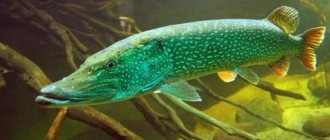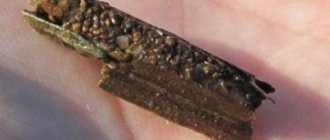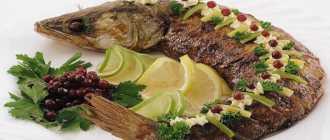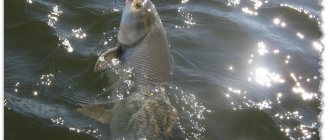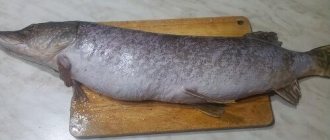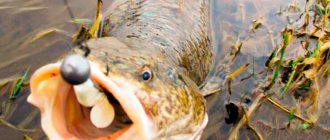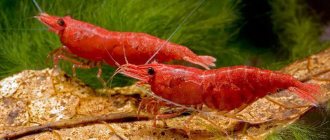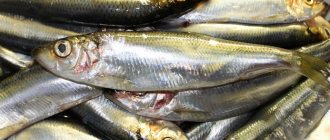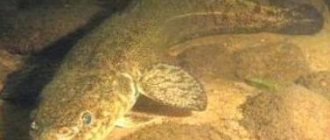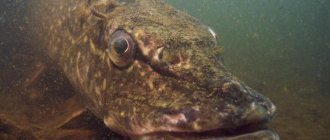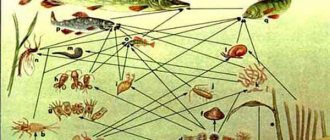When you mention the word pike, the memory of the fairy tale “At the Pike’s Command” instantly comes to mind, but in fact, the pike is far from a fairy-tale creature, but a real predatory fish.
Pay attention to the photo of the pike. This predator belongs to the ray-finned fish of the pike family, of the genus of the same name.
It is not known for certain where this name came from. Linguists believe that it comes from the word “frail”, judging by the outlines of the thin, elongated body.
According to the second option, it is believed that pike comes from the common Slavic word “skeu”, which means “to kill, cut.”
Appearance of a predator
The body length of a pike, by average standards, reaches 1 m and weighs 8.0 kg. There are exceptions in the form of giants 1.8 m long and weighing about 35.0 kg; females are always larger than males.
The pike's body is oblong and arrow-shaped. The head is long, the muzzle is narrow with the lower jaw extended forward. The oral cavity has structural features, which is why it is called a river shark.
On the lower jaw there are sharp teeth in the form of fangs of various sizes, which reliably capture prey. The upper jaw and other bones of the oral cavity are equipped with small teeth with points directed into the fish.
Having captured prey, brush-like teeth descend into the mucous mouths and prevent the prey from returning back to freedom.
The bones of the lower jaw are covered with epithelium of loose consistency; rows of 2-4 replacement teeth grow inside it. In place of the damaged working tooth, a soft replacement tooth appears, which over time grows to the jaw and becomes ossified.
The so-called change of teeth occurs. On the lower jaw, the teeth change completely unevenly. As a result, at the same time, in the mouth of the pike there are strong working fangs, mobile young and old, almost destroyed.
The pike's eyes are set high, and it can see far around it without turning its head. The lateral line of the predator is an organ of touch that instantly senses any small vibrations.Hidden in ambush, pike can wait for prey for a long time, standing motionless in thickets of vegetation. Having chosen a victim, it suddenly attacks it and swallows it from the head.
The entire body of the pike, cheeks and gills are covered with small scales. The color of the scales can be gray-green, gray-yellow or gray-brown depending on the environment and habitat. A darker color is characteristic of individuals living at depth.
The back of the pike is dark, the belly is white, possibly with gray spots. On the sides there are noticeable olive-colored spots merging into stripes. There are fins on the body: pectoral, ventral, unpaired (dorsal and anal).
Pike of different sexes have different urogenital openings: males have a narrow, oblong slit, females have a pink oval cavity.
The life cycle of pike is 10-30 years, depending on the species and habitat.
Step-by-step instructions for drawing with a simple pencil
A pike (the drawing for children in middle and high school should be more detailed), drawn in pencil, can be depicted schematically in the drawing. It is enough to correctly draw the body and head of the fish, and also show the location of the fins. This style of drawing is suitable for children over 7 years old, as well as those who do not like painstaking work.
Sketch
The sketch should be done with a hard pencil. All lines should be applied without pressure, otherwise they will be difficult to erase later.
Procedure:
- Draw an elongated oval in the center of the sheet.
- The head of the pike in this picture will be located on the right side, and the tail on the left. First you need to indicate the location of the gills. The pike has a large head. Therefore, from the edge of the oval you need to place a point in the area of 1/3 of the body.
- Draw the gills with an arcuate line.
- Give the head the correct shape. Draw the fish a high forehead and a long muzzle.
- Draw the jaws closed. The line separating them should be arched, and its ends should be downward.
- Draw a circle in the eye area.
- Use small ovals to indicate the location of the dorsal and ventral fins.
- Show the shape of the caudal fin.
Use an eraser to remove all unnecessary lines.
Detailing
Use a hard-soft pencil to draw all the details:
- On the head, highlight the frontal part with an arc.
- Draw indentations under the eyes.
- Draw several skin folds on the jaws, closer to the corners of the mouth.
- Give each fin a clearer outline. Their edges should have sharp jagged edges. Also add small spikes on the tail.
- Draw the fin bones in the form of curved lines.
- Add a few small lines near the gills. They will imitate scales.
- Draw a round pupil inside the eye.
Use a soft pencil to show a small dent near the eye. Erase all extra lines with an eraser.
Hatching
Strokes are applied with a soft pencil in certain directions.
- The caudal fin is shaded with vertical lines.
- Use horizontal strokes to paint over the lower fins.
- Paint the upper fin with diagonal stripes.
- Shade the lower part of the body and tail with horizontal and curved lines.
- Apply a few strokes in the head area, indicating dark areas.
- Trace the image of the pike along the contour with a soft pencil without pressing.
There is no need to shade the strokes. The drawing should be rough, with clear lines.
Nutrition
Pike in the spring, after a long hungry winter, pounces on everything and can chase prey for a long time until it gets its way. This will continue until her hunger is satisfied in the form of the victim’s tail protruding from the pike’s mouth.
Pike is very voracious and unpretentious; it will not disdain even its smaller relative. What can we say about the usual types of river fish, he won’t even miss the ruffe, although he eats it very carefully because of its prickliness.
In addition to fish, the following are suitable for food: crayfish, frogs, mice, moles and even sometimes squirrels migrating through the water. Particularly large representatives of the pike genus can catch a duckling, duck or drake.
Carp fish - description, main types, useful properties, habitats, catching + 78 photos- Loach - fish lifestyle, nutrition, reproduction process + 71 photos
- Silver carp - fish characteristics, habitats, fishing and bait features + 80 photos
Stages of drawing a pike:
- The most predatory fish in the river has an elongated body. Therefore, in order to get a drawing of a pike, you must first draw an oval in the center of the sheet and then divide it into two parts using a horizontal line.
- Now we begin to draw the outline of a pike in the middle of the oval, which has an arrow-shaped shape. On the left side there will be a head, which is also elongated. But on the right side we will leave space for the tail, where we should then draw the fin.
- Use an eraser to remove the horizontal line and the oval outline.
- On the right side we finish drawing the fin. We will also add small fins of different shapes and sizes along the lower and upper contours.
- Now you can go back to the front part of the muzzle, where you should draw the eye, mouth and gills. We define the outline of the entire drawing and, if necessary, remove unnecessary lines. Now the mouth immediately stands out against the general background. After all, it is oblong and the lower part protrudes forward.
- We draw detailed lines on each fin so that they look like real ones. After all, each line, using color, will create volume for the finished drawing.
- Many people know that pike can have different colors - from green to yellow and silver. But our river fish will have a gray-green color. So first of all, we take a dark green pencil, with which we completely fill the space in the middle of the outline of the drawing.
- Next, we add brown tones to the pike’s scales using a dark brown pencil. This way we will get new shades on the fins, body, tail and head of the river fish.
- Finally, using a black pencil, we create shadow relationships on all objects in the drawing, and also add an outline. We do this with neat strokes.
- If possible, take a white marker or gel pen. Using this tool, draw the lightest parts of the picture. This creates a cute drawing of a pike with colored pencils. With the help of such an image, you can more clearly get acquainted with such a predatory fish and study its structure with all its subtleties.
Varieties of pike
Common pike. A typical and most popular species, common in Eurasian and North American reservoirs. It grows up to one and a half meters in length and weighs about 8.0 kg.
American pike. Distributed in water bodies of the eastern regions of North American countries.
It is divided into subspecies: northern redfin and southern. These subspecies have a length of up to 30-45 cm and a weight of almost 1 kg. Their muzzle is shortened. They differ from the common species in the absence of orange fins. Life span is about 10 years.
Muskie pike. Rare large-sized species. Nicknamed by the Indians, it means ugly pike. Reaches a length of 1.8 m and weighs almost 32 kg. It is silver, gray-brown or green in color, with spots or stripes on the sides.
Pike is black or striped. Inhabitant of water bodies of North America. It is characterized by a length of almost 60 cm and a weight of about 2 kg. Looks like an ordinary one.
Pike perch - characteristics of the species, seasonality of catch, feeding and spawning + 81 photos- Ruff - characteristics, varieties, lifestyle, nutrition and reproduction + 56 photos
Horse mackerel - description, species, habitats, nutrition, spawning, recipes + 95 photos
Amur pike. Our compatriot lives in the reservoirs of Sakhalin and Amur. Its length is up to 115 cm and its weight is 20 kg. They have small silvery or greenish scales. Lifespan up to 14 years.
Southern or Italian pike. Inhabitant of Italian reservoirs. Previously it belonged to the common subspecies.
Aquitanian pike. Aquatic resident of France. A young species of pike, first discovered in 2014.
How to save caught pike
If the fisherman plans to preserve the pike head as a stuffed animal, you should take care of the caught trophy immediately after removing it from the reservoir. The first step is to carefully remove from the predator’s mouth . You can’t just pull out the tackle - this can damage the pike’s jaws and teeth .
Then the pike must be immobilized and wrapped in a damp cloth so that the skin does not dry out during transport of the trophy. Work on making a stuffed pike head begins immediately upon arrival from fishing: freezing or storing the fish is not advisable, since the skin will dry out and the jaws will become stiff.
Spawning period
Sexual maturity in females begins at 3-4 years of life, in males - at 5 years. As soon as the ice melts, at a temperature of the native environment of about 3-6 degrees, the spawning period begins. First in small individuals, then in large ones, at a depth of no more than 1 m. There are 2-4 males per medium-sized female, about 8 for a large one.
The volume of eggs depends on the size of the female: on average from 17 to 215 thousand eggs with a diameter of 3 mm.
Due to weak gluten, not all eggs attach to plants. After 3 days, the eggs fall to the bottom and continue to develop there.
The incubation period is 8-14 days. The hatched larvae, 6.7-7.6 mm in size, having lost their shell, feed on small crustaceans and daphnia.
Having reached 12-15 mm, the young animals switch to feeding on carp, which reproduce later than pike. A young pike, 5 cm long, feeds only on fry of other species.
These predators are considered a commercial fish, which is bred in artificial stocks, and an object of fishing.
Simple option
Now let's move on to a more detailed description to find out exactly how to draw a pike step by step. Let's start drawing with the head, which we will direct to the left. We make the preparation. A large open mouth, an elongated body, at the end of which the boundaries narrow and the lines diverge into the tail. On top of the back in the middle part we draw a large fin, which is divided by parallel stripes. Between this element and the tail we will create a smaller fin.
Let's detail the drawing. Let's draw the lips of the fish, add a round eye with a black pupil, and a little further draw the gills. Divide the tail into stripes. At the bottom of the belly we make fins: one in the middle (it will be forked), and the second is closer to the tail and smaller.
To make this model of fish as close as possible to a living exhibit, it should be given the appropriate coloring. Using a black pencil, we will place many dots on the top of the pike, including the fin and tail. Let's highlight the central stripe with a pink tint. We will paint the fins, tail and upper part of the fish dark green. Let's highlight the bottom with light green.
Pike fishing
Pike is a desired trophy for any fisherman. You can catch it all year round. How to catch pike? For this, various gear is used: fishing rods, donks, spinning rods, etc. The main thing is that the gear must be strong and durable.
The predator is mainly caught using live bait or artificial bait. Not only fish fry, but also frogs, worms, and caddis flies are used as live bait.
Places for fishing should be chosen near reeds, trees that have fallen into the water and other debris, where the pike could hide in ambush.
According to pike fishing professionals, an escaped predator perfectly retains in its memory the bait that caused it unpleasant sensations. In this regard, it is better to change the place or the bait itself.
Let's simulate the attack of this toothy predator
- The pike is in its favorite place and is hungry.
- A delicious crucian carp swims right at her.
- It floats out and floats past.
Strange, but understandable. In the frontal projection, the predator simply could not notice him, or, more likely, could not determine the speed of his movement and chose not to attack.
- Next, the crucian carp, remembering urgent matters, turns around and calmly swims back to the side of the pike.
- Everything is changing here. With lateral vision, the pike notices prey and determines the speed and direction of its movement.
- All that remains is to find out the distance for the attack. A turn follows, the pike needs to use binocular vision, followed by an attack, as a result of which the crucian carp is grabbed across the body.
- Next, it’s a matter of technique, turn the prey’s head towards the throat and swallow. Of course, the fish can swim at different angles and at different depths to the predator, but essentially nothing will change.
An analogy inevitably arises with a homing torpedo, from which it is difficult or impossible to escape, only the torpedo does not have such sharp teeth.
Photo of pike
Canning
Preservation of the head is carried out in a steep saline solution (10-12 tablespoons per liter of water). The head is placed vertically in an enamel bowl and completely filled with brine. Alternatively, all external and internal parts are generously sprinkled with coarse salt, especially trying to fill the space inside the gill covers and mouth.
The process of salting the head lasts at least 10 days . If the pike weighed more than 7 kilograms , preservation lasts two weeks . All this time, the dishes are kept at a temperature no higher than 7-8 degrees . The head actively secretes mucus, so it is removed from the brine once a day and washed under running water. The bulk of mucus from the head is secreted in the mouth and the space between the teeth , so these places must be washed especially thoroughly.
One of the preservation options is to fill the head with alcohol or a gasoline-alcohol mixture. In this case, the solution is changed every 3-5 days of preservation.
Attention! It is impossible to keep the head in brine for more than 14 days for the purpose of better preservation. This will cause the scales to begin to crumble and the appearance of the trophy will deteriorate.
How to draw a pike
Today's lesson is actually a continuation of the same topic - freshwater fish. Now we draw a pike.
The point is that in the world of freshwater fish, two forms dominate when it comes to body contours: the taller and flattened one (carp) and the more bar-shaped one (pike). To the first we also include bream, ide, crucian carp and, in general, most cyprinids, and, say, perch. For the second - pike, burbot, catfish. Of course, all this division is conditional, the head of a catfish or burbot is radically different from the head of a pike, and so are the fins. We focused specifically on the shape of the body, the ratio of length, width and height. There are also a lot of intermediate options; for example, it is unclear which of these two types include bleak or saberfish.
But let's return to the pike. Pike is a predator. We know that our pikes are also divided into two types: grass and bottom. Bottom fish are adult, heavy and lazy pikes; they lie on the bottom for hours and wait for prey. They are thicker and darker in color - matching the color of the bottom. The grassy one sits among the algae and attacks victims from this ambush. It is long and thin, and of course lighter in color to match the seaweed. Our pike is bottom-dwelling. I’m tired of these “grass”, there’s no sense or spirit in them, and on top of that they reek of mud. Let's draw a line for the stomach and back.
The pike lies on the bottom and does not move, we manage to see its insidious profile in all details. There is a very small hump on the back. You won’t notice it at all in young herbaceous plants. A huge head with a long predatory mouth. The mouth is very large and, if necessary, opens wide. But when she’s at rest, it will slam shut tightly: we’ll draw it that way, otherwise it’ll bite, God knows what’s on her mind. The tail tapers to a large forked fin. Count and position the fins correctly so that there is no disproportion. Our fish is long and placing the fins on its body is probably not so easy. The eyes are round, large and even somehow bulging, the nostrils stand out, not exactly snub-nosed, but the nose is a little upturned. This is a freshwater crocodile. (Read about how to draw a crocodile here).
Evgeniy Novikov told you how to draw a Carp fish and a Pike fish.
Tags: how to draw a fish, draw the underwater world, drawings of fish
